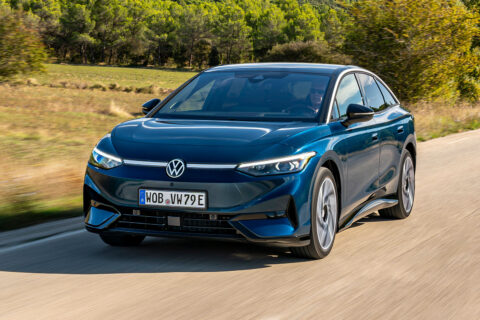That’s quite obvious inside. The Ioniq 6 wows you with its sheer amount of leg room, but a high floor and a low roof don’t make it all that great to spend time in. Not so in the ID 7. There’s marginally less leg room, but you can properly relax in the back, because you’re not forced into an awkward position.
The same goes for the front. While you don’t sit quite as low as you would do in a combustion-engined saloon, you don’t get the sensation of being hemmed in, as in the Ioniq 6, or of sitting in a bathtub, as in the EQE.
And unlike with the Ioniq 6 and Model 3, the boot (532 litres with a decent amount of space under the floor) is accessed via a big hatch, rather than a saloon bootlid.
I didn’t count just how many times the word ‘premium’ featured in the pre-drive briefing, but if it had been a drinking game, driving would have been inadvisable. This suggests that Volkswagen wants to take on BMW as much as Tesla.
In short, the ID 7 doesn’t quite feel on the same level as the BMW. For that, there are too many prosaic materials in prominent places and the design takes too many pages out of Tesla’s book of button-extermination.
Volkswagen proudly announced that its maligned touch-sensitive climate control bar now lights up in the dark. Well done, slow hand clap, etc. It’s still suboptimal, and the haptic controls on the steering wheel remain just as easy to press by accident and as hard to press on purpose as they always have been.
The infotainment touchscreen has even more to do than before, so we’re thankful that it has had a major upgrade. A faster processor means it responds instantly, and while the overhauled interface still isn’t the most logical around, most of the important functions are no more than two taps away.
On the upside, there are plenty of good features. Volkswagen tends to make good use of the flat floor in EVs, and that’s no different here: you will never be short of interior storage. The optional panoramic sunroof becomes transparent or opaque at the swipe of a touch-sensitive surface. Compared with a blind that slowly motors back and forth, this solution is much quicker and saves head room.
Given Volkswagen’s positioning of the ID 7 as a long-distance EV, what will really make the difference is the seats. Those in my test car were the optional Ergoactive ones, and they’re truly superb. Soft but supportive, with a plush velour upholstery and heating and ventilation (which can run at the same time), they are the opposite of the slightly knobbly seats in the Ioniq 6.
